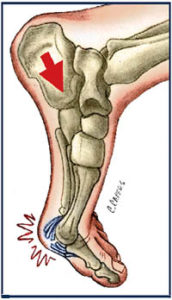I continue to receive many emails from high school, college and professional athletes asking for help with turf toe. Early detection and treatment make a big difference in these cases and it can completely change the course of the injury. Utilizing an effective treatment protocol also has a huge impact, as I will illustrate with the following examples.
One athlete who contacted me had his turf toe aggravated for over 6 weeks without relief. He eventually decided on surgery. This was after a month and a half of wearing a boot and immobilizing the toe joint. The surgery was successful, according to the doctors, but unfortunately, his toe is still in pain all the time. He is currently considering whether or not to have another surgery. Meanwhile he is implementing my technique of taping and self- treatment and is improving.
In contrast, another athlete contacted me after having issues with his toe for about 2 weeks. His doctor recommended that he wear a boot for 4-6 weeks. Following this protocol would have meant that the young athlete would completely miss out on his final season as a college soccer player, so he took matters into his own hands and sought an alternative treatment. Discovering my blogs on turf toe he wrote to me for advice. After implementing my turf toe protocol he was immediately able to participate fully in team practices. He then played in a game and scored. After 10 days he reported back that he was feeling great and the toe was 100%.
The term “turf toe” is used for most type of injuries to the big toe, particularly as it relates to athletes. This injury generally occurs in the joint where the toe meets the ball of the foot (the metatarsophalangeal joint) and is the result of an impact that jams the toe bones together. We all know how painful it can be to stub a toe. But this type of assault is worse because it’s high impact, meaning it happens at high speed, like when someone is jumping or running at full force.
Turf toe is one of the most widely misunderstood injuries when it comes to treatment protocol. The AMA protocol has been consistent: immobilization, boots, injections and potentially, surgery. Common practice looks at only the up and down movement of the toe joint when, in reality, the joint can rotate 360 degrees. In my mind, this misunderstanding about the nature of the joint is the cause of the common mis-treatment of turf toe. So until therapists start looking at the toe as a multi-dimensional joint, their treatments are going to fall short. Watch this short video for all you need to know about my turf toe protocol.
In my experience, successful resolution of turf toe involves very basic taping and self- treatment. But you don’t need to take my word for it. If you are dealing with a turf toe, try this non-invasive protocol and experience the results for yourself. It’s free, it’s easy, and it works. Watch the video, take charge of your treatment and you will feel better forever.


I currently have my middle finger in a splint for Mallet Finger. The doc said the ligaments might re-knit.
Is that pretty much the same thing only hand instead of foot?
Hi Brian. I’ve immobilized my great toe for almost 6 weeks and I went in today for a follow up. My first diagnose was a stress fracture it is completely healed. But I had recently been experiencing pain under the joint. I was then diagnosed with “turf toe” and now I am told to stay off of it for an additional 3 weeks and continue to immobilize in a boot. I’m a ballet dancer and would like to get back seeing I have a recital coming up. If I do these turf toe fixing exercising and taping should I continue to wear the immobilizing boot? Also I was told to have 2 ibeprophens and every meal and r.i.c.e. I just want to know on your take. My Doctor says if I do not immobilize I could tear or fracture this small bone.
I had the same thing when I hurt my toe practicing mixed martial arts. I went in to visit Dorfman once and I followed his post-session instructions. I was back to soccer and mixed martial arts within a week!
I hope all is well. I have been having big toe pain for 4 months.i am a female bball player. My toe only hurts when hyperextend it to much.I had an MRI and X-ray. The results came back okay. A foot surgeon specialists told me the ligaments and tendons are over stretched in my big toe. He also said there is nothing he a can do about it. I need to tape it and keep it stable.can you please help me? I really need my toe to heal so I can pursue my goals. Thank u
Keke,
Thank you for writing. Follow the taping protocol shown on the video embedded in this blog. It is also very helpful to mobilize the joint. I am the process of writing a second blog on turf toe that will debut the beginning of February. It will go into more detail about mobilization and taping of the toe. I also offer video consultations via FaceTime and Skype. In this way I could learn about the particulars of your case and and offer specific advice on how to resolve the issue.
My pain started three days ago. I tried the conventional taping first and it felt really bad. I saw your post today and followed your instructions, after one day I already feel like I can use my foot fairly normally. This is amazing. Thank you!
Carsten, thanks for your feedback. Glad your foot is feeling better! Take care, Brian
You, Sir are a Wizard. Thank you!